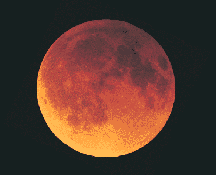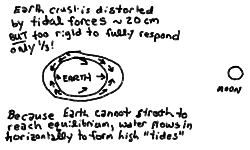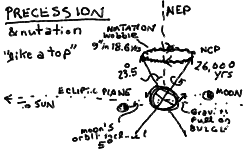 Atmospheres --- | ---
Eclipses
Atmospheres --- | ---
Eclipses

 Atmospheres --- | ---
Eclipses
Atmospheres --- | ---
Eclipses


Reading:
Chapter 2-3, 3-1 (ZG4)
 |
Key Question: | Why does the Moon keep the same face toward the Earth? |
|---|---|---|
 |
Key Principle: | Tidal Forces |
 |
Key Problem: | What is the evolution of the Earth-Moon system? |
 |
Key Quote: | "The tide is high but I'm movin on" - really naff Blondie song |
The tides raised upon the oceans (a poor choice of words as we will see) by the Moon are a complex and fascinating manifestation of the forces of gravity, rotational dynamics, the elasticity of the rock that makes up the Earth's crust, and fluid flow. And of course, if you live near or work on the high seas, a fact of life. The short version of the story is that the level of the ocean seems to rise and fall by a few feet twice each day, due to the inability of the solid earth to fully respond to the stresses induced by the Moon's gravitational influence.
Note what I did not say: that the Moon's gravity pulls the oceans up away from the Earth. The tides are not raised by the Moon, at least not directly. The tidal force caused by one body upon another is a stretching and compressing effect due to the differing strengths of the gravitational force being applied to parts of the "target body" (Earth) at different distances from the "originating" body (Moon). As we will see when we discuss Newton's theory of gravitation, the gravitational force from an object is proportional to the mass divided by the square of the distance, so stuff farther away feel less gravity. The point on the Earth nearest the Moon is 12800 km closer than the opposite point (the moon is roughly 384000 km from the center of the Earth). The difference in force between the closest and farthest parts of the Earth from the Moon tries to stretch the Earth along the line with the Moon (and to compress it in the perpendicular direction). The size of the effect is that the surface of the Earth should be stretched by about 60cm. Note that if the Earth were to do so, we would notice nothing, since the oceans would move outward like a thin skin on the surface. In physics-speak, the Earth will respond to the tidal force so as to remain in equilibrium between its own gravity and that of the Moon, and since we would remain in equilibrium we would only notice a very very slight change in our weight (the pull of Moon would slightly cancel the pull of the Earth when above us). This is hard to grasp in our gut, but it is so.
Why do we see the oceans seem to rise and fall? And why twice a day? It is because the Earth's rocky crust is stiff (try and stretch a rock!!!) and cannot move the full 60cm --- it is tidally stretched by only 20cm or so --- that the desired equilibrium is not reached. The uncancelled forces cause a horizontal flow of the water into the regions that should have been stretched, ie. the sub-lunar point (toward the moon) as well as the opposite side. Thus there are 2 equal places with respect to the moon where the flow causes the ocean level to rise, with a drop in between. Here is a sketch of this:

The rotation of the Earth carries a particular geographic point, say on the coast of New Jersey, through the "bulges" toward and away from the Moon. A good way of thinking about this is to note that since if the Earth were to stretch fully as the Moon's tidal force would like it to we would notice nothing, we can pretend that in this case the Earth were to remain spherical. The inability of the Earth to stretch all the way would then be like squashing the surface of the Earth along the Earth - Moon line down by 40cm, and watching the water flow along the surface into those regions.
Tidal Friction and Length of Day
What goes around comes around. If the rather modest-sized Moon causes noticible tides on the much larger Earth, then we would expect the Earth to have a larger effect on the Moon. Indeed this is so, except the Moon has long since dealt with this problem by not moving its surface with respect to the Earth! This is the reason that the Moon keeps the same hemisphere toward the Earth during its orbit, with a rotational period equal to its orbital period. Over much of the 5 billion year history of the solar system, the relentless tidal force of the Earth has tidally locked the Moon's rotation into step with its orbit, so that there is no relative motion to cause frictional forces through changing stresses.
The same thing is happening to the Earth, though it has not had time to really affect things much since the tidal stress from the Moon is so much smaller. The friction induced by the stresses combined with the Earth's rotation relative to the Moon is slowing down the Earth's rotation by the tiny amount of 1.6 ms (or 1.6 x 10^-3 sec) per century! Thus, about 450 million years ago, the day was only 22 hours long. At this rate, it will take about 146 billion years to slow the Earth enough to lock with the Moon's orbit of 27 days.
The rotation of the Earth makes it behave like a top or gyroscope spinning in space. If the Earth were a uniform perfect sphere, then the rotation axis would remain pointed in the same direction for all time, just like a gyroscope in a spacecraft guidance system. However, the Earth is not perfectly spherical - it is made of a slightly uneven distribution of rocks, magma, and an iron core, with a tasty coating of fauna, flora, and air. The Earth's crust, though made of rock, is not perfectly stiff, and the extremely fast rotation causes it to flatten slightly at the poles relative to the equator.
The rotation speed of the Earth (a circumference of 40000 km spinning around in 24 hours, or about 1700 km/hour) causes centrifugal forces on the equatorial crust to pull those regions outward. This shape of a squashed sphere is called an oblate spheroid. The equatorial diameter of the Earth is about 43 km larger than the polar diameter.
Because the Sun and Moon are not in the equatorial plane of the Earth, this equatorial bulge does not line up with the gravitational forces caused by the Sun and Moon. These forces acting upon the spinning Earth cause the rotation axis to change in orientation, or precess, much like gravity causes a top to precess its spin axis. Precession carries the rotation axis around in a circle or cone about the axis defined by the ecliptic poles, at the constant inclination angle of 23.5 degrees.

Because the forces of the Sun and Moon act to "upright" the spinning Earth, the precession is in the direction opposite to the spin. In the case of a top, gravity is trying to pull it over, so the precession is in the same direction as the spin.
The period of the precession is one circuit every 26,000 years. This means that the celestial longitude (Right Ascension) of the stars will change at the rate of 50" every year.
The plane of the Moon's orbit is inclined at 5 degrees to the ecliptic plane. This slight mismatch causes a wobble in the precession, or nutation of about 9.2" with a period of 18.6 years.
 Prev Lecture ---
Prev Lecture ---
 Next Lecture ---
Next Lecture ---
 Astr11 Index ---
Astr11 Index ---
 Astr11 Home
Astr11 Home
smyers@nrao.edu Steven T. Myers